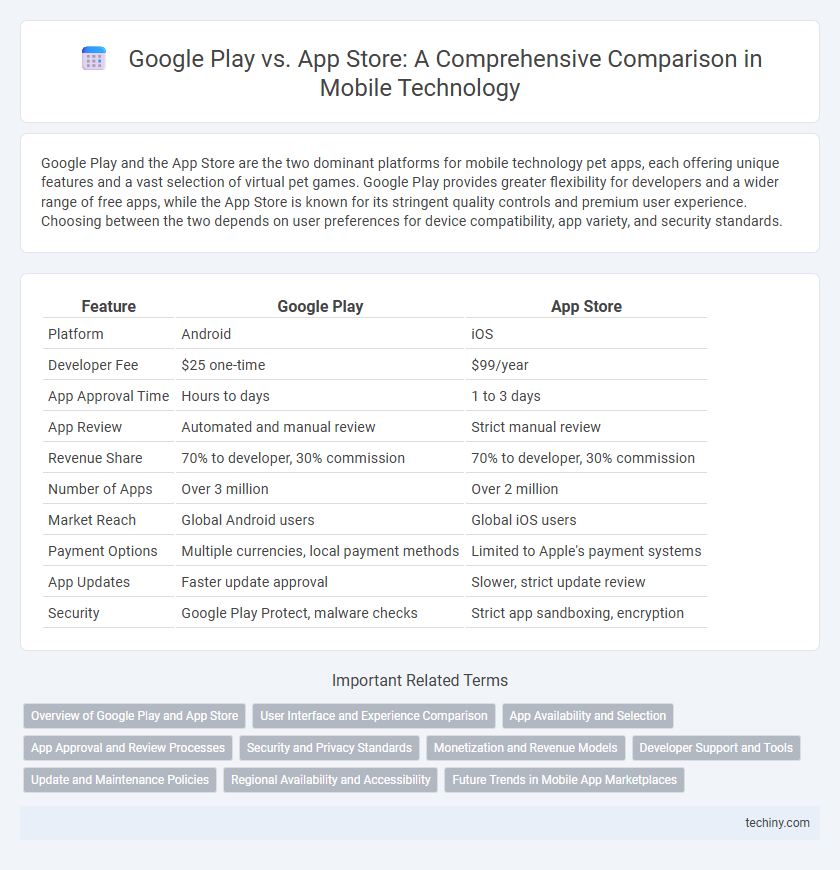Google Play and the App Store are the two dominant platforms for mobile technology pet apps, each offering unique features and a vast selection of virtual pet games. Google Play provides greater flexibility for developers and a wider range of free apps, while the App Store is known for its stringent quality controls and premium user experience. Choosing between the two depends on user preferences for device compatibility, app variety, and security standards.
Table of Comparison
| Feature | Google Play | App Store |
|---|---|---|
| Platform | Android | iOS |
| Developer Fee | $25 one-time | $99/year |
| App Approval Time | Hours to days | 1 to 3 days |
| App Review | Automated and manual review | Strict manual review |
| Revenue Share | 70% to developer, 30% commission | 70% to developer, 30% commission |
| Number of Apps | Over 3 million | Over 2 million |
| Market Reach | Global Android users | Global iOS users |
| Payment Options | Multiple currencies, local payment methods | Limited to Apple's payment systems |
| App Updates | Faster update approval | Slower, strict update review |
| Security | Google Play Protect, malware checks | Strict app sandboxing, encryption |
Overview of Google Play and App Store
Google Play offers over 3 million apps, primarily catering to Android devices, with a flexible app submission process and lower fees for developers. The App Store features approximately 2.2 million apps, focusing on iOS devices with stringent app review guidelines to ensure quality and security. Both platforms dominate mobile app distribution but differ significantly in user demographics, revenue models, and app ecosystem policies.
User Interface and Experience Comparison
Google Play offers a customizable interface with easy navigation and personalized recommendations, enhancing user engagement through adaptive content. The App Store emphasizes a clean, visually consistent design with curated editorial content, prioritizing simplicity and discoverability for iOS users. Both platforms optimize user experience by leveraging distinct design principles aligned with their respective ecosystems.
App Availability and Selection
Google Play offers over 3.5 million apps, covering a broader range of categories and often featuring more experimental or niche applications compared to the App Store's approximately 2.2 million apps. The App Store emphasizes quality control with stringent review processes, resulting in a curated selection focused on security, user privacy, and premium experiences. Both platforms cater to different ecosystems, with Google Play favoring Android users seeking variety and customization, while the App Store prioritizes iOS users desiring a polished and reliable app environment.
App Approval and Review Processes
Google Play streamlines app approval with automated reviews and a typically faster process, enabling quicker updates and releases for developers. Apple's App Store enforces a rigorous manual review focusing on content quality, security, and policy compliance, which can extend approval times but often results in higher app trustworthiness. Both platforms prioritize user safety and platform integrity but differ significantly in review transparency and speed.
Security and Privacy Standards
Google Play and the App Store implement robust security measures to protect user data, with both platforms employing app review processes that identify malware and enforce strict permission policies. Apple's App Store maintains a strong emphasis on user privacy through its transparency labels and stringent developer guidelines, offering greater control over app data access. Google Play enhances security by leveraging Google Play Protect and AI-driven threat detection, continuously scanning apps for vulnerabilities while promoting user consent for data sharing.
Monetization and Revenue Models
Google Play generates revenue primarily through paid app downloads, in-app purchases, and subscription models, benefiting from a larger global user base that supports diverse monetization strategies. The App Store, known for higher user spending, emphasizes in-app purchases and subscriptions, with a significant share of revenue stemming from its premium pricing model and stricter app review policies. Developers often choose the App Store for higher revenue potential despite the rigorous approval process, while Google Play appeals through broader market reach and flexible monetization options.
Developer Support and Tools
Google Play offers developers a flexible publishing process with extensive documentation, a robust suite of APIs, and the Android Studio IDE for app development, optimizing customization and testing. The App Store provides comprehensive developer tools through Xcode, integrated with Swift and Objective-C, alongside strict guidelines that ensure high app quality and security. Both platforms feature strong analytics and user engagement tools, but Google Play emphasizes open-source integration while Apple prioritizes a controlled ecosystem for consistent performance.
Update and Maintenance Policies
Google Play offers more flexible update policies with faster approval times and frequent incremental app updates, enabling developers to roll out bug fixes and features promptly. In contrast, the App Store enforces stricter review processes with comprehensive guidelines, often resulting in longer update approval periods but ensuring higher app quality and security. Both platforms mandate regular maintenance and compliance with evolving policies to maintain app availability and protect user experience.
Regional Availability and Accessibility
Google Play boasts wider regional availability, supporting over 190 countries and offering diverse app selections tailored to local markets, while Apple's App Store is accessible in around 175 countries with stringent regional content regulations. Google Play's accessibility is enhanced by compatibility with a broad range of Android devices, making it more inclusive in emerging markets, whereas the App Store prioritizes optimized experiences on iOS devices but limits cross-device accessibility. Regional payment methods and language support also differ, with Google Play offering more flexible options suited for various economic environments compared to Apple's more standardized, premium-focused approach.
Future Trends in Mobile App Marketplaces
Google Play and the App Store are evolving rapidly, with AI-driven personalization and augmented reality integration shaping future user experiences. Both marketplaces increasingly emphasize privacy, security enhancements, and support for cross-platform apps to meet growing developer and consumer demands. Emerging trends such as blockchain-based app verification and subscription-based revenue models are set to redefine mobile app distribution and monetization.
Google Play vs App Store Infographic

 techiny.com
techiny.com